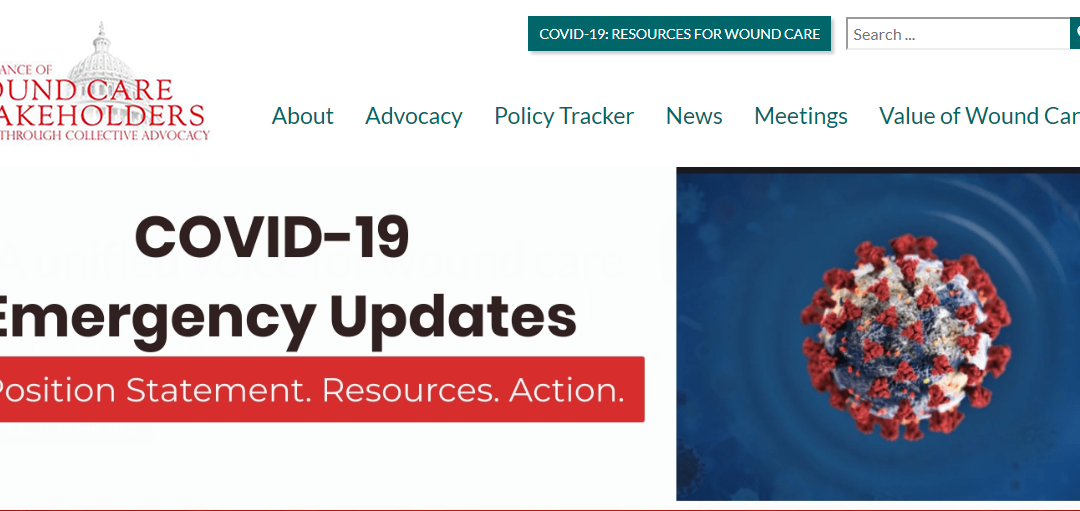The Alliance of Wound Care Stakeholders has created a “one-stop” shop to for the rapidly changing, vital information relevant to Wound Care practitioners in the COVID-19 era. Here’s a link to that information, which changes almost daily:
CMS is working with stakeholders to craft new rules or temporarily wave regulations that act as barriers to patient care in this unprecedented situation. While the speed with which these changes are taking place is gratifying, it is impossible for any single practitioner, business or institution to keep up with them. Furthermore, regulator changes important to us may not be easy to spot or interpret. We need help! That’s what the Alliance is for. Consider the Alliance part of your essential COVID-19 PPE (personal protective equipment) – which enables you to safely provide patient care. (Learn more about the work of the Alliance at www.woundcarestakeholders.org).
Alliance Executive Director, Marcia Nusgart has provided the following vital summary of relevant changes and associated resources:
CMS just released tonight many temporary regulatory waivers and new rules to equip health care providers with flexibility to respond to the COVID-19 pandemic. Here is a link to the entire list of CMS actions:
Wound Care Physicians and Other Clinicians:
- Signature Requirements: CMS is waiving signature and proof of delivery requirements for Part B drugs and Durable Medical Equipment when a signature cannot be obtained because of the inability to collect signatures. Suppliers should document in the medical record the appropriate date of delivery and that a signature was not able to be obtained because of COVID-19.
- To the extent that a National Coverage Determination (NCD) or Local Coverage Determination (LCD) would otherwise require a face-to-face visit for evaluations and assessments, clinicians would not have to meet those requirements during the public health emergency.
- Beneficiary consent should not interfere with the provision of telehealth services. Annual consent may be obtained at the same time, and not necessarily before, the time that services are furnished.
- Physician visits: CMS is waiving the requirement in 42 CFR 483.30 for physicians and non-physician practitioners to perform in-person visits for nursing home residents and allow visits to be conducted, as appropriate, via telehealth options.
- Medicare Physician Supervision requirements: Direct physician supervision is no longer required for non-surgical extended duration therapeutic services provided in hospital outpatient departments and critical access hospitals. Instead, a physician can provide a general level of supervision for these services so that a physician is no longer required to be immediately available in the office suite.
- Physician Services: CMS is waiving 482.12(c)(1-2) and (4), which requires that Medicare patients in the hospital be under the care of a physician. This allows hospitals to use other practitioners, such as physician’s assistant and nurse practitioners, to the fullest extent possible. This waiver should be implemented in accordance with a state’s emergency preparedness or pandemic plan.
- National coverage determinations (NCDs) and Local Coverage Determinations (LCDs): To the extent NCDs and LCDs require a specific practitioner type or physician specialty to furnish or supervise a service, during this public health emergency, the Chief Medical Officer or equivalent of a hospital or facility will have the authority to make those staffing decisions.
Hospitals:
- Physical Environment: CMS is waiving certain requirements under the conditions at 42 CFR §482.41 and §485.623 to allow for flexibilities during hospital, psychiatric hospital, and CAH surges. CMS will permit non-hospital buildings/space to be used for patient care and quarantine sites, provided that the location is approved by the State (ensuring safety and comfort for patients and staff are sufficiently addressed). This allows for increased capacity and promotes appropriate cohorting of COVID-19 patients.
Home Health:
- Homebound Definition: A beneficiary is considered homebound when their physician advises them not to leave the home because of a confirmed or suspected COVID-19 diagnosis or if the patient has a condition that makes them more susceptible to contract COVID-19. As a result, if a beneficiary is homebound due to COVID-19 and needs skilled services, an HHA can provide those services under the Medicare Home Health benefit.

Dr. Fife is a world renowned wound care physician dedicated to improving patient outcomes through quality driven care. Please visit my blog at CarolineFifeMD.com and my Youtube channel at https://www.youtube.com/c/carolinefifemd/videos
The opinions, comments, and content expressed or implied in my statements are solely my own and do not necessarily reflect the position or views of Intellicure or any of the boards on which I serve.



